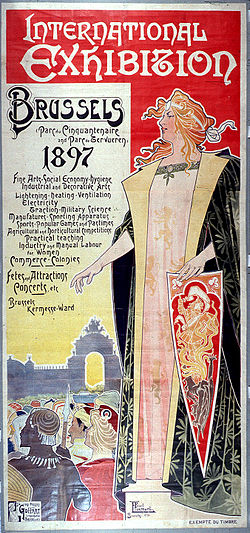Brussels World's Fair 1897
| World Exhibition Brussels 1897 Exposition Internationale de Bruxelles |
|
|---|---|
 Exhibition poster by Henri Privat-Livemont |
|
| General | |
| Exhibition space | 132 ha |
| Number of visitors | 7.8 million |
| BIE recognition | Yes |
| participation | |
| countries | 27 countries |
| Exhibitors | 10,668 exhibitors |
| Place of issue | |
| place | Brussels |
| terrain |
Jubelpark , Tervuren Coordinates: 50 ° 50 ′ 30 ″ N , 4 ° 23 ′ 19.4 ″ E |
| calendar | |
| opening | May 10, 1897 |
| closure | November 8, 1897 |
| Chronological order | |
| predecessor | Chicago 1893 |
| successor | Paris 1900 |
The World Exhibition of 1897 in Brussels ( fr: Exposition Internationale de Bruxelles ) was the twelfth world exhibition recognized by the Bureau International des Expositions (BIE) . It took place between May 10, 1897 and November 8, 1897. 27 countries and 10,668 exhibitors took part. The exhibition had 7.8 million visitors.
history
The world exhibition took place in the Jubelpark ( fr: Parc du Cinquantenaire ) on an area of 36 hectares . King Leopold II used the opportunity to carry out a colonial exhibition on the Free State of the Congo on an area of 96 hectares as part of the World Exhibition in Tervuren . The Free State of the Congo was then the personal property of the king.
The two exhibition grounds were connected with a newly built tram line, today's tram line 44, and with the " Avenue de Tervueren ", also newly created for the exhibition . The exhibition in Brussels was the first world exhibition with its own scientific thematic exhibition ( fr: Section des sciences ), which was dedicated to mathematics , physics and natural science .
The Secretary General of the Colonial Ministry, Baron van Etvelde, commissioned the architect Paul Hankar (1859–1901) and the three craftsmen Gustave Serrurier-Bovy (1858–1910), Hobé and Henry van de Velde to furnish a hall . The initiative to hand over such an official commission to artists instead of experienced decorators was a remarkable step.
An Art Nouveau Colony Palace was built for the colonial exhibition. The most important imported products (including coffee , cocoa and tobacco ) from the Congo, ethnographic objects and stuffed, exotic animals were presented. A Congolese village was built in the park in Tervuren, in which 267 Africans lived during the exhibition.
Furthermore, special and strange freshwater fish from the Congo were shown in an underground connecting passage.
This exhibition was a huge success: in five months the exhibition in Brussels attracted 6 million and the colonial exhibition in Tervuren 1.8 million visitors. The exhibition generated a profit of 1.3 million Belgian francs (US $ 260,000). After the exhibition ended, the Colonial Palace was still used as the Royal Museum for Central Africa .
Picture gallery
literature
- Winfried Kretschmer: History of the world exhibitions . Campus, 1999, ISBN 3-593-36273-2 .
Web links
- World Exhibition Brussels 1897. Bureau International des Expositions (English). Retrieved March 23, 2017 .
Individual evidence
- ^ Henry van de Velde: p. 117, World Exhibition Brussels 1897. Accessed April 18, 2020 .
- ↑ Adam Hochschild: King Leopold's Ghost: a Story of Greed, Terror, and Heroism in Colonial Africa . Papermac, London, 2000, ISBN 978-0333765449
- ↑ From the Congo Museum to the KMZA , Royal Museum for Central Africa in Tervuren, accessed on January 31, 2014





